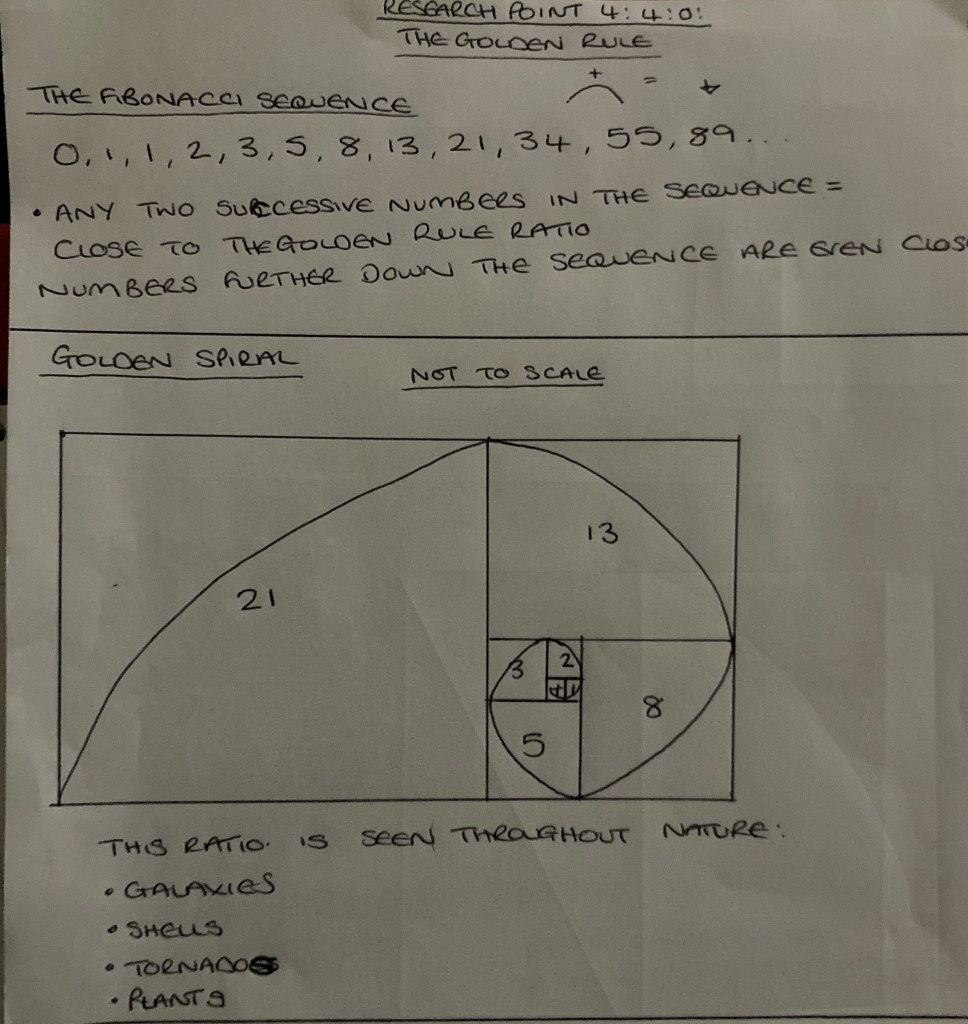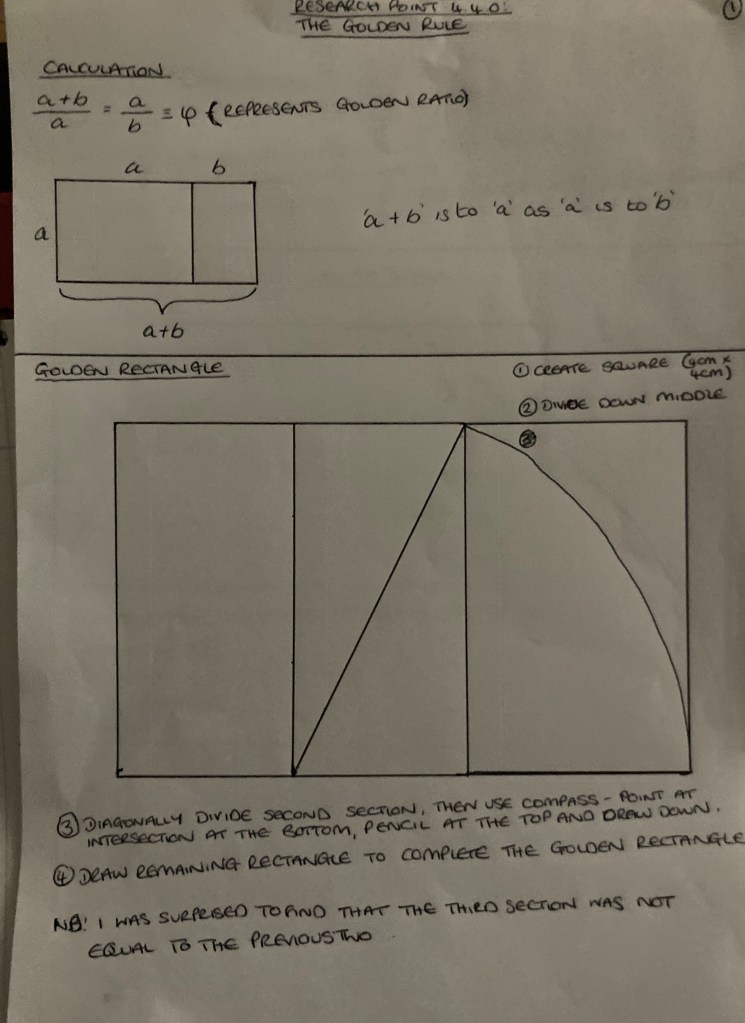The Golden Rule
This is an area I have yet to research and so I am rather intrigued as to what my findings will be. I began by researching in general what this term meant and was rather surprised as to what I was able to come across.
Overall, it appears that the ‘golden ratio’ known and used by many artists to create aesthetically pleasing pieces equates to 1 : 1.618. Whilst this initially appears to be a random set of numbers, I am aware that mathematics plays a large role in the world of art; the use of shapes such as circles, spirals, triangles, spheres etc have been somewhat imperative in creating numerous works throughout history. I am aware that artists regularly scale up or down previous sketches or photographs and have used this technique somewhat in my own work, however, the mathematical principle shown above is rather new to me and I was eager to work out what was so special about this number.
The ‘Golden Rule’ is known by several different names, including ‘Golden Section’ and ‘Divine Proportion’. The mathematical principle is used by architects, mathematicians and artists alike. The earliest known use of the Golden Rule is the Parthenon statues created by Phidias in 490-430BC.
During my research, I came across some visual examples of the ratio and decided to draw them out for myself as this really does help me understand as opposed to just reading about it.

Page One 
Page Two 
Page Three
After carrying out the above exercises, I was absolutely amazed at the quiet genius of the mathematical principle, discovery and its connection to nature. I am often amazed by things of this nature and just find it completely mind-blowing how complex the world around us can be and how all the wonders of physical nature can be broken down to just some seemingly random numbers! When faced with situations like this, I cannot help but be reminded of The Matrix and wonder whether this world can be real or whether we are actually a very small part of some form of computer-generated universe because it all just seems far too ‘controlled’ to be just ‘happy accidents’.
Another thing I find truly remarkable is that, ok, yes it is still fantastic that we can learn these things nowadays, but we have the assistance of such things as rulers, calculators and computers to aid us in simplifying what can become extremely complex studies, but what about when we think back to the Parthenons created back in 490-430BC when these things couldn’t even be dreamed of?! That is what completely blows my mind. How such people as Phidias, Leonardo da Vinci, Fibonacci and so on were just utterly remarkable creations of the world.
I often wonder about the births of people like this and whether their parents had even the remotest of inklings of just how phenomenal a mind their child was going to have and the impacts they would have on the world around them for immeasurable time. Thinking along this sort of line, I wonder about creating pieces considering the childhoods or births of people of this caliber – the viewer knows what is to come, but the people within the pieces are completely oblivious and there is no way for the viewer to break through the ‘window’ of the canvas to raise their awareness of something they will never be able to know, let alone comprehend. This is definitely a path I would like to consider further down the line in my learning journey.
This piece of research has really taken me on a journey of discovery and learning and is something I will definitely bear in mind going forward.
Rule of Thirds
Having researched this topic heavily previously (both in Drawing Skills 1 and earlier in this course), I decided to simply recap on what I have learned with regard to composition to refresh my memory:
- The further away objects are, the more the colour in the object will lose its saturation. The closer the object is to the background, the closer its colour will be to that of the background (i.e. sky). For example, if looking at a forest of green trees receding into the background which is a blue sky, the colour of the trees will change from the green to the blue of the sky, but will become duller and paler as they near the background.
- The temperature of colours used will change as they recede to match that of the background. Blues are cooler, whereas reds are warmer. If the background is blue and the foreground red, the temperature of the red will slowly change to match that of the background.
- Atmosphere has a significant role to play in the colours we see. The closer something is, the less atmospheric particles there are between the viewer and the object. The further away something is, the more atmospheric particles there are. This atmosphere also impacts the temperature of the colours; those which are closer are much warmer in appearance and those further away much cooler. This also means that when working atmospherically, the further away an object is, the brighter its value and the lighter the colour will be.
- Cast shadows can also play a big part in creating the illusion of depth. Placing the shadow around the outside of the page with n inward gradient, with a person in the middle can create the illusion of a person being in a cave, with their path forwards lit only by the light of a candle. The same is also true for the reverse. If a person is placed on a page with the darkness appearing to radiate from the centre of the page with an outward gradient, the person will then appear to be walking towards a dark hole in the distance.
- The strokes used in the painting process also play a role in creating depth within a piece. Using larger strokes for objects in the foreground and smaller ones for those in the background will assist in creating the illusion of depth. The direction of the brushstrokes will also assist in leading the viewer’s eye inward.
Bibliography
ArtNet. (2015) ‘See How Artists Discover Simplicity as an Art Form in Works Which Reflect the Golden Ratio’ [Online] At: https://news.artnet.com/art-world/golden-ratio-in-art-328435#:~:text=See%20How%20Artists%20Discover%20Simplicity,Which%20Reflect%20the%20Golden%20Ratio&text=Also%20known%20as%20the%20Golden,larger%20of%20the%20two%20quantities. (Accessed on 9 October 2020)
Draw Paint Academy. (2017) ‘Using The Golden Ratio (AKA Golden Mean) To Improve Your Artworks’ [Online] At: https://drawpaintacademy.com/golden-ratio-in-art/ (Accessed on 9 October 2020)


One thought on “Research Point 4.4.0: The Golden Rule and the Rule of Thirds”